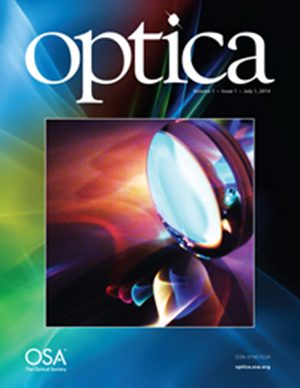Low loss fiber-coupled volumetric interconnects fabricated via direct laser writing
IF 8.4
1区 物理与天体物理
Q1 OPTICS
引用次数: 0
Abstract
Photonic integrated circuits (PICs) are vital for high-speed data transmission. However, optical routing is limited in PICs composed of only one or a few stacked planes. Further, coupling losses must be low in deployed systems. Previously, we developed the subsurface controllable refractive index via beam exposure (SCRIBE) technique to write accurate 3D gradient refractive index (GRIN) profiles within a mesoporous silica scaffold. Here, we apply SCRIBE to fabricate low loss, broadband, polarization insensitive, fiber-coupled, single-mode volumetric interconnects that include waveguides traversing arbitrary 3D paths. By seamlessly integrating mode-matching subsurface lenses and GRIN waveguide tapers, calibrating for positional writing errors, implementing multipass exposure, automating alignment, and switching to antireflection coated fibers, we reduced the insertion loss for a fiber-PIC-fiber interconnect from 50 to 2.14 dB, or 1.47 dB, excluding the fiber array’s loss. Further, we establish an upper bound of 0.45 dB loss per coupler. We report quality factors of 27,000 and 77,000 and bending losses of 6 and 3 dB/cm for 15 and 30 µm radii microrings, respectively. We also demonstrate Bézier escalators, polarization-rotating and polarization-splitting interconnects, and a seven-channel 25 µm pitch volumetric interconnect. The SCRIBE platform presents a clear path toward realizing 3D PICs with unique functionality.通过直接激光写入技术制造的低损耗光纤耦合体积互连器件
光子集成电路(PIC)对于高速数据传输至关重要。然而,光路由在仅由一个或几个堆叠平面组成的 PIC 中受到限制。此外,已部署系统的耦合损耗必须很低。在此之前,我们开发了通过光束曝光的表面下可控折射率(SCRIBE)技术,在介孔二氧化硅支架中写入精确的三维梯度折射率(GRIN)剖面。在这里,我们应用 SCRIBE 制作低损耗、宽带、偏振不敏感、光纤耦合的单模体积互连器件,其中包括穿越任意三维路径的波导。通过无缝集成模式匹配次表面透镜和 GRIN 波导锥,校准位置写入误差,实施多通道曝光,自动对准,以及改用抗反射涂层光纤,我们将光纤-PIC-光纤互连的插入损耗从 50 dB 降低到 2.14 dB,或 1.47 dB(不包括光纤阵列的损耗)。此外,我们还确定了每个耦合器的损耗上限为 0.45 dB。我们的报告显示,15 和 30 µm 半径微镜的品质因数分别为 27,000 和 77,000,弯曲损耗分别为 6 和 3 dB/cm。我们还演示了贝塞尔自动扶梯、偏振旋转和偏振分裂互连以及七通道 25 微米间距容积互连。SCRIBE 平台为实现具有独特功能的 3D PIC 提供了一条清晰的道路。
本文章由计算机程序翻译,如有差异,请以英文原文为准。
求助全文
约1分钟内获得全文
求助全文
来源期刊

Optica
OPTICS-
CiteScore
19.70
自引率
2.90%
发文量
191
审稿时长
2 months
期刊介绍:
Optica is an open access, online-only journal published monthly by Optica Publishing Group. It is dedicated to the rapid dissemination of high-impact peer-reviewed research in the field of optics and photonics. The journal provides a forum for theoretical or experimental, fundamental or applied research to be swiftly accessed by the international community. Optica is abstracted and indexed in Chemical Abstracts Service, Current Contents/Physical, Chemical & Earth Sciences, and Science Citation Index Expanded.
 求助内容:
求助内容: 应助结果提醒方式:
应助结果提醒方式:


